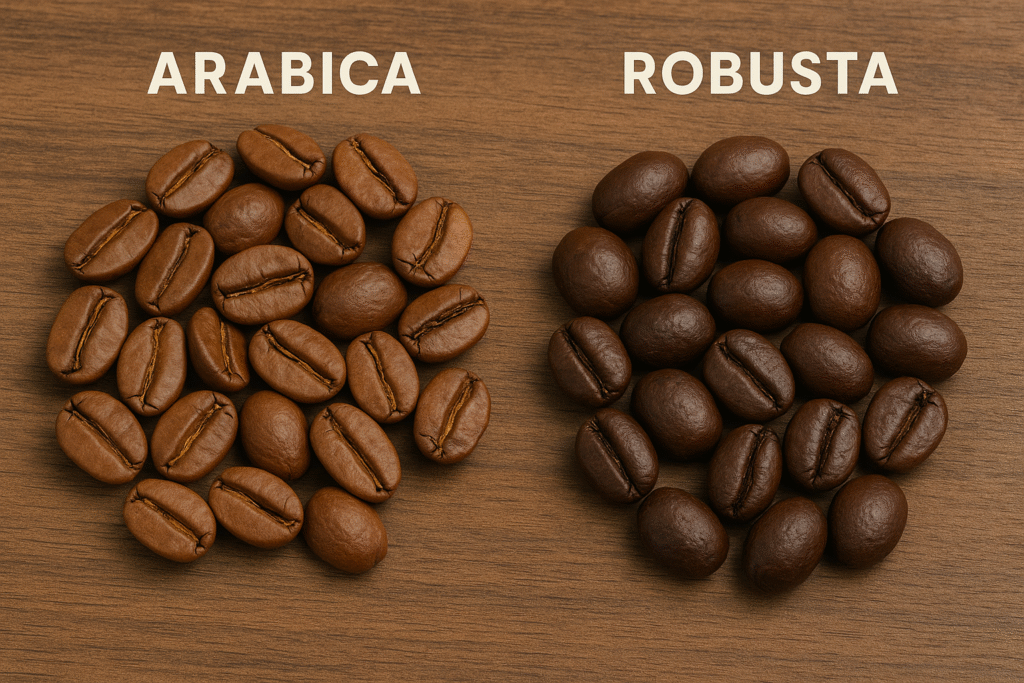Coffee is one of the most consumed beverages in the world, but many coffee lovers don’t realize that the drink they enjoy daily usually comes from two main types of beans: Arabica and Robusta. Although they both belong to the Coffea family, they are significantly different in flavor, growing conditions, price, and usage. In this article, we’ll dive into the unique characteristics of each and help you understand which one suits your taste best.
The Origins of Arabica and Robusta
Coffea Arabica was first discovered in the highlands of Ethiopia and has been cultivated for over a thousand years. It is considered the original coffee plant and is responsible for about 60-70% of the world’s coffee production.
On the other hand, Coffea Canephora, commonly known as Robusta, was discovered much later in central and western sub-Saharan Africa. Robusta plants are generally easier to grow and are more resistant to pests and harsh weather conditions compared to Arabica.
Growing Conditions
The two coffee species thrive in very different environments:
- Arabica prefers cooler, subtropical climates, usually grown at altitudes between 600 and 2,000 meters above sea level. It requires more care and specific conditions to flourish.
- Robusta thrives at lower altitudes (200 to 800 meters), needs a warmer climate, and can tolerate higher temperatures and greater humidity levels. It is a hardy plant that is much more resilient against diseases.
Because Arabica needs more careful cultivation, it often costs more to produce, impacting the final retail price of Arabica coffee.
Flavor Profile: Subtlety vs. Strength
The flavor is where the difference between Arabica and Robusta becomes most noticeable:
- Arabica beans offer a smoother, sweeter taste with hints of fruits, sugar, and berries. They tend to have higher acidity, which gives the coffee a lively and bright flavor profile.
- Robusta beans, in contrast, have a stronger, harsher taste, often described as earthy or woody, with a more bitter finish. Robusta also has a grainy or nutty note that makes it feel heavier on the palate.
If you enjoy a delicate and nuanced cup of coffee, Arabica is likely to be your preference. However, if you like a bolder, stronger flavor (often used in espressos), Robusta might be more suitable.
Caffeine Content
Another important distinction is caffeine content:
- Robusta beans have about 2.2–2.7% caffeine.
- Arabica beans contain about 1.2–1.5% caffeine.
The higher caffeine content in Robusta acts as a natural pesticide, helping the plant to resist pests more easily. It also explains the stronger, more bitter flavor of Robusta coffee.
If you’re seeking a bigger caffeine kick, Robusta blends are the way to go.
Visual and Physical Differences
When looking at the beans themselves, Arabica and Robusta are quite distinct:
- Arabica beans are oval-shaped with a curved crease.
- Robusta beans are more circular and have a straight crease.
This physical difference is subtle but can be spotted by a trained eye. Additionally, roasted Robusta beans are often darker and oilier compared to Arabica beans.
Pricing and Market Position
Because Arabica beans are more difficult to grow and require specific conditions, they are generally more expensive than Robusta beans. Specialty coffees and high-end blends usually use 100% Arabica beans to ensure premium flavor.
Robusta, due to its affordability and strong taste, is often used in instant coffees, cheaper blends, and in some espresso blends to add body and crema.
Health Benefits
Both types of coffee offer health benefits:
- Arabica’s lower caffeine content may be gentler on sensitive stomachs.
- Robusta’s higher caffeine level has been associated with enhanced alertness and even mild antibacterial properties.
Regardless of the type, moderate coffee consumption has been linked to reduced risks of certain diseases, such as type 2 diabetes and Alzheimer’s.
Which One Is Better?
The answer depends on what you’re looking for in your cup:
- Choose Arabica if you value a smooth, refined flavor with complex notes and lighter body.
- Choose Robusta if you want a strong, bold taste, higher caffeine content, and a budget-friendly option.
For many coffee enthusiasts, a blend of both offers the best of both worlds: the sweetness of Arabica combined with the strength and crema-producing ability of Robusta.
Final Thoughts: A Matter of Personal Preference
Whether you prefer Arabica or Robusta comes down to personal taste and usage. Both have important places in the global coffee culture. If you haven’t tried both separately yet, consider brewing them side by side—you might be surprised at how distinct each cup can be.
Understanding the differences between Arabica and Robusta not only deepens your appreciation for coffee but also helps you make better choices based on your flavor preferences, caffeine needs, and even budget.
